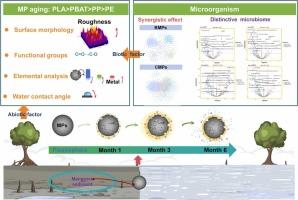Microplastic aging and plastisphere succession in mangrove sediments: Mechanisms, microbial interactions, and degradation potential
IF 11.3
1区 环境科学与生态学
Q1 ENGINEERING, ENVIRONMENTAL
引用次数: 0
Abstract
The unique alternating aerobic-anaerobic conditions in mangrove sediments create hotspots for microplastic (MP) aging. We systematically investigated the aging characteristics of conventional MPs (CMPs: mPP and mPE) and biodegradable MPs (BMPs: mPLA and mPBAT) and spatiotemporal successions of plastisphere communities (in three mangrove regions over 1, 3, and 6 months). The results showed that MP aging increased with plastisphere succession, and aging severity followed the order: mPLA > mPBAT > mPP > mPE. Crucially, BMPs exhibited higher risks of heavy metal leaching and secondary MP release. Geographic location was the primary driver of microbial community structure, followed by MP type and time. Network analysis revealed that alternating aerobic-anaerobic conditions promoted positive microbial correlations. CMP communities were more sensitive to organic carbon than BMPs. BMPs were more prone to be utilized as carbon sources by microbes, thereby accelerating their aging. Plastisphere microbiomes enriched potential MP-degrading taxa (e.g., Alcanivorax, Ketobacter, Halomonas, Desulfovibrio, Desulfobulbus) and displayed higher hydrocarbon degradation potential than sediments. Potential MP-degrading taxa resembled hydrocarbon degraders. Anaerobic MP-degraders correlated more strongly with aging indicators than aerobic MP-degraders, particularly on BMPs. Partial least squares path model (PLS-PM) showed that biotic factors were positively correlated with MP aging. MP aging was jointly controlled by biotic and abiotic factors.

红树林沉积物中的微塑性老化和塑性圈演替:机制、微生物相互作用和降解潜力
调查数据表明,微粒径聚乙烯(mPE)和微粒径聚丙烯(mPP)是红树林中最常见的塑料球类型。虽然在初始监测中未检测到微粒径聚乳酸(mPLA)和微粒径聚己二酸丁二酯(mPBAT)等可生物降解塑料(bp),但其消费量呈持续增长趋势。MP衰老前期实验期为6个月。此外,微生物的生物量。在好氧和厌氧交替的条件下,所有四种MP类型的表面形貌都随着时间的推移而逐渐改变,包括皱纹的出现、孔隙的形成、突起和小颗粒(图2和图S2-3)。其中,bmp(特别是mPBAT)表面的小颗粒形成最为明显。值得注意的是,MP表面上的小颗粒数量并没有遵循简单的线性趋势。结论本研究系统地阐明了红树林沉积物在好氧和厌氧交替条件下MPs的老化特征和塑圈微生物群落的演替。MPs的老化程度主要受MPs类型和时间的影响。MPs老化会释放次生MPs,引起金属元素的迁移,从而加剧环境风险。地理位置是微生物群落结构的主要驱动因素,其次是MP类型和环境影响。本研究探讨了好氧-厌氧交替条件下沉积物中MP老化、风险传递和微生物相互作用。MP老化导致次生MP的释放和重金属元素的转移,从而增加了环境风险。这些发现强调了适当的塑料废物管理对防止长期生态影响的重要性。通过确定参与MP降解的关键微生物类群,本研究为作者贡献声明提供了有价值的见解。秦永强:调查。文章:方法论。苏媛媛:写作—审编,写作—原稿,方法论,调查。雷军:方法论。彭立成:写作——原稿、资源、资金获取、构思。尹连正:调查。刁小平:写作——原稿、监督、资源、项目管理、构思。竞争利益声明作者声明,他们没有已知的竞争经济利益或个人关系,可能会影响本文所报道的工作。本研究得到海口市科技重点规划项目(2023-010)、海南省自然科学基金项目(323MS010)、海南省自然科学基金青年基金项目(优秀青年项目,424YXQN415)、国家自然科学基金项目(42466006)、海南省南海人才培养项目-南海创新人才(第三批)、海南省自然科学基金重点项目
本文章由计算机程序翻译,如有差异,请以英文原文为准。
求助全文
约1分钟内获得全文
求助全文
来源期刊

Journal of Hazardous Materials
工程技术-工程:环境
CiteScore
25.40
自引率
5.90%
发文量
3059
审稿时长
58 days
期刊介绍:
The Journal of Hazardous Materials serves as a global platform for promoting cutting-edge research in the field of Environmental Science and Engineering. Our publication features a wide range of articles, including full-length research papers, review articles, and perspectives, with the aim of enhancing our understanding of the dangers and risks associated with various materials concerning public health and the environment. It is important to note that the term "environmental contaminants" refers specifically to substances that pose hazardous effects through contamination, while excluding those that do not have such impacts on the environment or human health. Moreover, we emphasize the distinction between wastes and hazardous materials in order to provide further clarity on the scope of the journal. We have a keen interest in exploring specific compounds and microbial agents that have adverse effects on the environment.
 求助内容:
求助内容: 应助结果提醒方式:
应助结果提醒方式:


